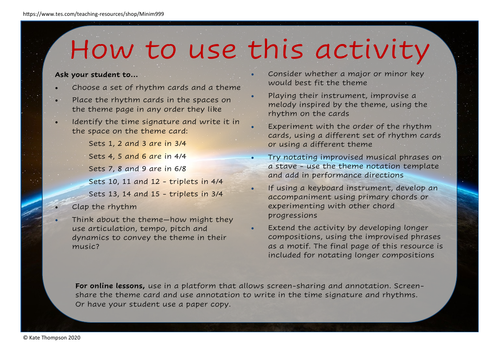

This printable activity is intended for use in musical instrumental lessons, (or class music lessons where pitched instruments are available), to:
- Support strong rhythmic skills
- Make improvisation fun and accessible
- Develop musical expression through the use of dynamics, tempo, articulation and pitch
- Incorporate an understanding of time signatures
- Inspire composition
For online lessons, use in a platform that allows screen-sharing and annotation. Screen-share the theme card and use annotation to write in the time signature and rhythms. Or have your student use a paper copy.
Includes
- Five theme cards
- Five themed notation templates
- 15 sets of rhythm cards, of varying complexity (in the time signatures 4/4, 3/4 and 6/8)
- Rhythm sets range from those suitable for beginners, to more complex rhythms including triplets
- Instructions
The five themes included are:
- The dragon’s keep
- The hidden glade
- The wilderness
- Sunrise
- The secret dell
Activity instructions
- Choose a set of rhythm cards and a theme
- Place the rhythm cards in the spaces on the theme page in any order they like
- Identify the time signature and write it in the space on the theme card:
Sets 1, 2 and 3 are in 3/4
Sets 4, 5 and 6 are in 4/4
Sets 7, 8 and 9 are in 6/8
Sets 10, 11 and 12 – triplets in 4/4
Sets 13, 14 and 15 – triplets in 3/4 - Clap the rhythm
- Think about the theme—how might they use articulation, tempo, pitch and dynamics to convey the theme in their music?
- Consider whether a major or minor key would best fit the theme
- Playing their instrument, improvise a melody inspired by the theme, using the rhythm on the cards
- Experiment with the order of the rhythm cards, using a different set of rhythm cards or using a different theme
- Try notating improvised musical phrases on a stave – use the theme notation template and add in performance directions
- If using a keyboard instrument, develop an accompaniment using primary chords or experimenting with other chord progressions
- Extend the activity by developing longer compositions, using the improvised phrases as a motif. The final page of this resource is included for notating longer compositions
Something went wrong, please try again later.
This resource hasn't been reviewed yet
To ensure quality for our reviews, only customers who have purchased this resource can review it
Report this resourceto let us know if it violates our terms and conditions.
Our customer service team will review your report and will be in touch.
£5.00